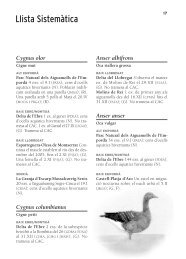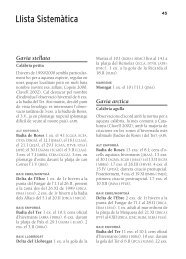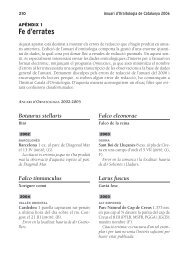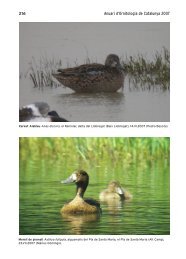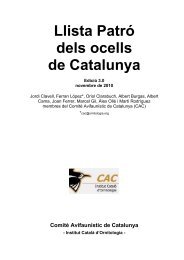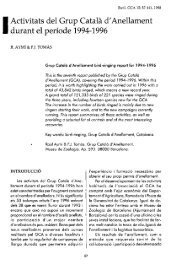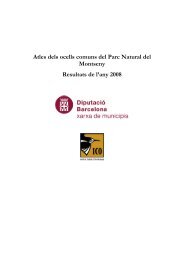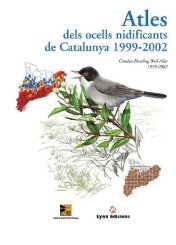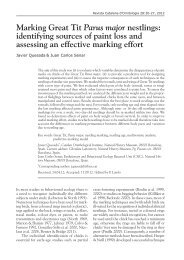I Dades sobre la muda de la terretitona Calidris minuta a Mallorca ...
I Dades sobre la muda de la terretitona Calidris minuta a Mallorca ...
I Dades sobre la muda de la terretitona Calidris minuta a Mallorca ...
Create successful ePaper yourself
Turn your PDF publications into a flip-book with our unique Google optimized e-Paper software.
Butll. GCA 9: 1-6,1992<br />
I<br />
<strong>Da<strong>de</strong>s</strong> <strong>sobre</strong> <strong>la</strong> <strong>muda</strong> <strong>de</strong> <strong>la</strong> <strong>terretitona</strong><br />
<strong>Calidris</strong> <strong>minuta</strong> a <strong>Mallorca</strong> (Illes Balears)<br />
P. GARCIAS & G. GARGALL0<br />
Data on the moult of the Little Stint <strong>Calidris</strong> <strong>minuta</strong> in Majorca<br />
(Balearic Is<strong>la</strong>nds).<br />
The remex moult of 28 adult and 2 1 first winter Little Stints was<br />
checked in Majorca (Balearic Is<strong>la</strong>nds) during November and<br />
December 1 99 1. The intensity of postnuptial moult was very low:<br />
only 6 (30%) out of 20 birds with unfinished moult were in active<br />
moult, with ari average of one feather growing per wing. Fourteen<br />
birds had suspen<strong>de</strong>d their moult. First winter birds moulted no<br />
primaries or secondaries in the postjuvenile moult, but they moulted<br />
the tertials to varying extents. These stages of moult can be<br />
exp<strong>la</strong>ined by the ecology of the area, which is one of the most<br />
northerly wintering grounds for Little Stints.<br />
Key words: Little Stint, <strong>Calidris</strong> <strong>minuta</strong>, moult, suspen<strong>de</strong>d rnoult,<br />
Maiorca.<br />
Pere Garcias. GOE. Verí 1 3" 07001 Palma <strong>de</strong> <strong>Mallorca</strong><br />
Gabriel Gargallo. GCA. Museu <strong>de</strong> Zoologia. Apt.593,<br />
08080-Barcelona.<br />
Rebut: 25.02.92; Acceptat: 1 8.05.92<br />
Les terretitones <strong>Calidris</strong> <strong>minuta</strong> adultes<br />
realitzen una <strong>muda</strong> postnupcial completa. La<br />
<strong>muda</strong> <strong>de</strong> les remiges sol tenir lloc lluny <strong>de</strong><br />
les urees <strong>de</strong> cria, sovint als quarters d'hiver-<br />
nada, per6 <strong>de</strong> vega<strong>de</strong>s també durant <strong>la</strong><br />
migració (Cramp & Sirnrnons 1983). La <strong>la</strong>ti-<br />
tud <strong>de</strong> I'area <strong>de</strong> <strong>muda</strong> semb<strong>la</strong> influir en <strong>la</strong><br />
seva durada i moment en que té lloc: al<br />
nord-oest dlAfrica es realitza entre agost i<br />
setembre amb una durada d'uns 60 dies<br />
(Pienkowski et al. 1976), mentre que a Sud-<br />
Africa i Kenia té lloc <strong>de</strong> novembre a abril<br />
en uns tres o quatre mesos (Middlemiss<br />
1 96 1 , Pearson 1 984)).<br />
La <strong>muda</strong> postiuvenil generalment és corn-<br />
pleta, i les prirnaries es mu<strong>de</strong>n entre <strong>de</strong>sern-<br />
bre i abril. A I'est dfAfrica, pero, una petita<br />
part <strong>de</strong>ls ocells joves so<strong>la</strong>ment renoven les<br />
5 o 6 primeries més externes (Cramp &<br />
Simmons 1 983, Pearson 1 984).<br />
Fins ara I'estudi <strong>de</strong> I'estat <strong>de</strong> <strong>la</strong> <strong>muda</strong><br />
d'aquesta especie, bé durant <strong>la</strong> migració <strong>de</strong><br />
tardor o durant <strong>la</strong> seva hivernada a <strong>la</strong> Pe<br />
ninsu<strong>la</strong> lbérica i les Balears, ha estat total-<br />
ment <strong>de</strong>sates. El present treball aporta al-<br />
gunes da<strong>de</strong>s <strong>sobre</strong> <strong>la</strong> <strong>muda</strong> <strong>de</strong> <strong>la</strong> <strong>terretitona</strong>
Butli. GCA 9, 1992<br />
a I'hivern a <strong>Mallorca</strong>, on és un ocell migrant<br />
regu<strong>la</strong>r i hiverrant escas (GOB 1990).<br />
gar-se durant mesos (Ginn & Melville 1983,<br />
Pearson 1 984).<br />
t'estudi va tenir lloc al salobrar <strong>de</strong> Carn- 1<br />
DOS. <strong>Mallorca</strong> 39.20N 03.00E, entre els<br />
Muda portnupcial<br />
0 .<br />
dies 23 <strong>de</strong> novembre i 1 6 <strong>de</strong> <strong>de</strong>sembre <strong>de</strong> Pel que fa referencia a I'estat <strong>de</strong> <strong>muda</strong><br />
199 1 . La zona té una extensió d'unes 400 <strong>de</strong> les primaries, <strong>de</strong>ls 28 ocells capturats 1 O<br />
Ha. Al seu interior hi ha una explotació (35,7%) I'havien finalitzat, 5 (17,9%) essalinera<br />
que manté aigua als estanys, que taven en <strong>muda</strong> activa i 13 (46,4%) I'havien<br />
ocupen una superficie d'unes 100 Ha, du- suspes. La puntuació mitjana <strong>de</strong> <strong>la</strong> <strong>muda</strong> a<br />
rant tot I'any. Durant els mesos <strong>de</strong> gener i les primaries <strong>de</strong>ls ocells amb <strong>muda</strong> activa<br />
febrer es registren les temperatures mitjanes , era 48 (s.d.= 2.2) mentre que en els ocells<br />
més baixes <strong>de</strong> I'any, amb unes oscil.<strong>la</strong>cions amb <strong>la</strong> <strong>muda</strong> suspesa era 32,6 (s.d.= 5.6);<br />
térmiques que po<strong>de</strong>n assolir els 15' <strong>de</strong> di- <strong>la</strong> diferencia és significativa (Mann-Whitney<br />
ferencia entre el dia i <strong>la</strong> nit (UIB 1989). Els U-test, U=O; P>0.05). Aquestes diferencies<br />
ocells es van capturar om b xarxes en les puntuacions mitjanes són encara més<br />
japoneses, en total 28 adults i 21 <strong>de</strong> primer grans si tenim en compte que en <strong>la</strong> terretihivern.<br />
La datació es va fer a partir <strong>de</strong>ls<br />
- caracters exposats per Prater et a1.(1977). ,<br />
Controls durant el <strong>de</strong>sembre i gener<br />
tona, a I'igual que en altres limícoles, <strong>la</strong><br />
:enovació <strong>de</strong> les primaries en els estadis<br />
inicials <strong>de</strong> <strong>muda</strong> és mes rapida i que aquest<br />
d'aquests ocells capturats al novembre (1 0 ritme <strong>de</strong> renovació disminueix a mesura que<br />
<strong>de</strong> 49) indiquen que una gran part <strong>de</strong> <strong>la</strong> <strong>la</strong> <strong>muda</strong> finalitza (¡.e. <strong>la</strong> re<strong>la</strong>ció entre !a<br />
pob<strong>la</strong>ció anel<strong>la</strong>da és d'ocells hivernants. puntuació <strong>de</strong> les primaries i el temps no és<br />
A cada ocell se li varen fer les mesures lineal) (Pienkowski et al 1976, Pearson<br />
biometriaues habituals (I'a<strong>la</strong> -corda maxima- 1984). Tenint en comte I'estat <strong>de</strong> <strong>la</strong> <strong>muda</strong><br />
i el pes) i' les corresponents anotacions <strong>sobre</strong> postnupcial al coniunt <strong>de</strong> totes les remiges,<br />
I'estat <strong>de</strong> <strong>la</strong> <strong>muda</strong> (vegeu Ginn & Melville 8 (28,5%) I'havien acabat, 6 (2 1,4%) es-<br />
1983). La <strong>muda</strong> so<strong>la</strong>ment es va estudiar a taven en <strong>muda</strong> activa, amb una mitiana<br />
les remiges i si no es diu el contrari !es d'una ploma en creixement per a<strong>la</strong> (s.d=O),<br />
observacions corresponen a I'a<strong>la</strong> esquerra. i 14 (50%) I'havien suspes.<br />
Les primaries i terciaries estan numera<strong>de</strong>s Els ocells que suspenen <strong>la</strong> renovació <strong>de</strong><br />
<strong>de</strong>scen<strong>de</strong>ntment i les secundaries ascen<strong>de</strong>nt- les primaries solen <strong>de</strong>ixar <strong>de</strong> <strong>muda</strong>r algunes<br />
ment. En el present estudi <strong>la</strong> terciaria més secundaries internes (Tau<strong>la</strong> 1 ), generalment<br />
interna, que és m0rfol6~icament molt dif- 3 ó 4, i, mes rarament <strong>la</strong> terciaria més<br />
erent, no s'ha tingut en compte (Pearson externa. Tant aquests com els ocells en <strong>muda</strong><br />
19841, i <strong>la</strong> primaria n" 1 1, que és vestigial, activa seguien <strong>la</strong> seqüencia <strong>de</strong> <strong>muda</strong> típica<br />
no va ser inclosa en <strong>la</strong> puntuació <strong>de</strong> <strong>la</strong> <strong>muda</strong> <strong>de</strong> I'especie (Pearson 1984). En dos ocells<br />
a les primaries. atípics, <strong>la</strong> <strong>muda</strong> <strong>de</strong> les primaries estava aca-<br />
El terme <strong>muda</strong> "sus~esa" es refereix a bada quan encara els quedaven <strong>la</strong> S9 i les<br />
aquell procés <strong>de</strong> renovdció <strong>de</strong> les remiges S8-S10 per <strong>muda</strong>r. En 'un altre ocell atípic<br />
que s'interromp i que posteriorment, quan es <strong>la</strong> <strong>muda</strong> <strong>de</strong> les primaries estava suspesa<br />
reinicia, es fa respectant <strong>la</strong> seqüencia mu- tenint les sis primaries més internes <strong>muda</strong><strong>de</strong>s<br />
dada previament. La durada <strong>de</strong> <strong>la</strong> interrup- i, excepte !es S2-S4, totes les secundaries<br />
ció pot ser d'uns quants dies o bé perdon- noves.
Muda <strong>de</strong> <strong>la</strong> Terretitona<br />
I<br />
Primhies Secundiries Terairies 1<br />
'- 1 0 9 8 7 6 5 4 3 2 1 1 2 3 4 5 6 7 8 9 1 0 ~ 5 4 3 2<br />
I 2 2 2 5 8 13 14 14 14 14 14 12 12 12 11 10 8 3 2 3 110 14 14 14 Ad.(nlO<br />
1 O O O O O O O O O O O O O O O O O O O O13 61621 1W.(n21)<br />
I<br />
I<br />
Tau<strong>la</strong> 1. FreqüPncia <strong>de</strong> renovació <strong>de</strong> les rPmiges <strong>de</strong>ls ocells adults en <strong>muda</strong> suspesa i <strong>de</strong>ls<br />
ocells <strong>de</strong> primer hivern.<br />
Table 1. Frequency of moult of each remex in adults with suspen<strong>de</strong>d moult and in first winter birds.<br />
Muda postjuvenil I temps possible, per evitar que <strong>la</strong> <strong>de</strong>manda<br />
! energetica requerida per <strong>la</strong> <strong>muda</strong> superi, en<br />
Els oces joves solen <strong>muda</strong>r les dues / algun moment, <strong>la</strong> que l'ocell es capag <strong>de</strong><br />
terciaries més internes (Tau<strong>la</strong> 1); <strong>de</strong>ls 2 1 , trobar (Pienkowski et al. 1976).<br />
ocells 3 les havien <strong>muda</strong>t totes i 2 no n'ha- l'alta inci<strong>de</strong>ncia <strong>de</strong> <strong>la</strong> <strong>muda</strong> suspesa<br />
vien <strong>muda</strong>t caD. Nomes un <strong>de</strong>ls ocells mostrada en el wresent estudi no semb<strong>la</strong><br />
presentava mud'a activa. Cap <strong>de</strong>ls ocells estar lligada a un'a estrategia <strong>de</strong> perllongahavia<br />
renovat alguna primaria o secundaria. ció <strong>de</strong> <strong>la</strong> <strong>muda</strong>. Les condicions ambientals<br />
(temperatures i hores <strong>de</strong> llum) <strong>de</strong> I'hivern<br />
balear són més dures que a I'oest <strong>de</strong>l Mar-<br />
DISCUSSIO roc i molt més aue a Kenia (GOB 19901.<br />
I Tal com Dassa dl Marroc. el; ocells <strong>de</strong> 1;s<br />
La inci<strong>de</strong>ncia <strong>de</strong> <strong>la</strong> <strong>muda</strong> suspesa, a I<br />
I'igual que <strong>la</strong> durada total <strong>de</strong> <strong>la</strong> <strong>muda</strong> post- (<br />
arees <strong>de</strong>'<strong>muda</strong> més nbrdiques eviten <strong>muda</strong>r<br />
durant l'hivern, moment en e qual molts limínupcial<br />
(Pearson 1984), esta intimament Iligoda<br />
a les condicions bioambientals <strong>de</strong>l (<br />
coles es troben amb una gran manca <strong>de</strong><br />
recursos (Goss-Gustard 1969, Pearson<br />
cicle biologic <strong>de</strong> I'ocell. En un estudi realitzat 1984, Zwarts et al 1990). De <strong>la</strong> mateixa<br />
durant <strong>la</strong> tardor (agost- setembre) a I'oest <strong>de</strong>l I forma que augmenta <strong>la</strong> duresa i <strong>la</strong> duració<br />
Marroc, on les terretitones portaven a terme <strong>de</strong> I'hivern, amb <strong>la</strong> <strong>la</strong>titud ho fan les restric<strong>la</strong><br />
<strong>muda</strong> postnupcial, Pienkowski et cions al bptim disponible per <strong>muda</strong>r.<br />
a1.(1976) van trobar nomes en un exemp<strong>la</strong>r, La taxa <strong>de</strong> <strong>muda</strong> suspesa que trobem al<br />
d'un total <strong>de</strong> 273 ocells estudiats, signes <strong>de</strong> present estudi i <strong>la</strong> proporció tan baixa<br />
<strong>muda</strong> suspesa. Segons Pearson (1 984), d'ocells en <strong>muda</strong> activa (d'entre tots aquells<br />
eren pocs els ocells que arribaven a <strong>la</strong> seva que no han acabat <strong>de</strong> <strong>muda</strong>r) amb un nomarea<br />
d'estudi <strong>de</strong> Kenia amb <strong>muda</strong> suspesa, bre tan baix <strong>de</strong> plomes creixent s~multuniapero<br />
aquesta apareixia sovint entre aquells ment, semb<strong>la</strong> ser <strong>la</strong> resposta a aquestes<br />
ocells que posteriorment feien <strong>la</strong> <strong>muda</strong> post- limitacions (gener i febrer són els Kesos més<br />
nupcial a <strong>la</strong> seva area. Aquestes diferencies, freds a <strong>Mallorca</strong>, GOB 1990). A Kenia <strong>la</strong><br />
i el fet aue <strong>la</strong> durada <strong>de</strong> a <strong>muda</strong> <strong>de</strong> <strong>la</strong> susoensió <strong>de</strong> <strong>la</strong> <strong>muda</strong> és una interncoció<br />
terretitond a Kenia és més <strong>de</strong>l doble que al mkentania que té <strong>la</strong> funció <strong>de</strong> regui& <strong>la</strong><br />
Marroc, semblen indicar que <strong>la</strong> <strong>muda</strong> sus- durada <strong>de</strong> <strong>la</strong> <strong>muda</strong> postnupcial dins un hipesa<br />
podria operar com un mecanisme <strong>de</strong> vern l<strong>la</strong>rg i benevol (Pearson 1984). Als<br />
perllongació <strong>de</strong> <strong>la</strong> durada <strong>de</strong> <strong>la</strong> <strong>muda</strong>, <strong>de</strong><br />
forma que aquesta s'estengui el maxim <strong>de</strong> 1<br />
quarters d'hivernada més nordics semb<strong>la</strong> ser<br />
part d'una estrategia <strong>de</strong> <strong>muda</strong> que evita <strong>la</strong>
Butll. GCA 9.1992<br />
utilització d'energia per renovar el plomatge<br />
durant el ~erio<strong>de</strong> <strong>de</strong> maximes restriccions<br />
trofiques. (a millora termica que sol tenir lloc<br />
a partir <strong>de</strong>l mes <strong>de</strong> marG (GOB 1990) podria<br />
aportar les condicions necessaries per<br />
a I'acabament <strong>de</strong> <strong>la</strong> <strong>muda</strong> postnupcial als<br />
ocells en <strong>muda</strong> suspesa que passen I'hivern<br />
a l'il<strong>la</strong>.<br />
D'acord amb I'estat <strong>de</strong> renovació <strong>de</strong> les<br />
primaries <strong>de</strong>ls ocells adults, po<strong>de</strong>m trobar<br />
dos grups ben diferenciats. Aquell que esta<br />
amb <strong>la</strong> <strong>muda</strong> suspesa (el 46% <strong>de</strong>ls ocells),<br />
en un estadi intermedi <strong>de</strong> renovació <strong>de</strong>l plomatge<br />
i aquell que trobem en <strong>muda</strong> activa<br />
pero finalitzant o bé ia ho ha fet (el 54%<br />
<strong>de</strong>ls ocells). Malgrat que <strong>la</strong> mostra és molt<br />
petita, aquestes diferencies semblen indicar<br />
que <strong>la</strong> pob<strong>la</strong>ció estudiada podria estar formada<br />
per dos grups pob<strong>la</strong>cionals diferents,<br />
amb una fenologia migratoria o zones <strong>de</strong><br />
<strong>muda</strong> distintes o bé ambdues coses.<br />
Segons Pearson (1984), durant el seu<br />
primer hivern les terretitones realitzen una<br />
<strong>muda</strong> <strong>de</strong>l cos i seguidament <strong>la</strong> <strong>muda</strong> <strong>de</strong> les<br />
remiges i <strong>de</strong> les rectrius. Pienkowski et al<br />
(1 976) no van trobar cap ocell al Marroc<br />
<strong>muda</strong>nt les primaries durant <strong>la</strong> seva primera<br />
tardor, pero es podria tractar d'ocells migrant~<br />
que posteriorment mu<strong>de</strong>ssin <strong>la</strong> resta<br />
<strong>de</strong>l plomatge als quarters d'hivernada. Al<br />
present estudi no hem trobat cap ocell que<br />
hagi <strong>muda</strong>t alguna primaria o secundaria,<br />
per6 si terciaries (tau<strong>la</strong> 1 ). El patró <strong>de</strong> <strong>muda</strong><br />
<strong>de</strong> les terciaries segueix <strong>la</strong> ten<strong>de</strong>ncia trobada<br />
en moltes altres especies durant <strong>la</strong> <strong>muda</strong><br />
postjuvenil <strong>de</strong> <strong>muda</strong>r, <strong>sobre</strong>tot, les més internes.<br />
D'aquesta manera es renoven aquelles<br />
plomes que tenen un paper més important<br />
en <strong>la</strong> protecció <strong>de</strong> I'a'il<strong>la</strong>ment físic i termic<br />
<strong>de</strong> I'ocell envers I'exterior (Gauci & Sultana<br />
1979, Mester & Prünte 1982, Gargallo<br />
ob~.~ers.). Desconeixem si posteriorment<br />
aquests ocells duran a terme una <strong>muda</strong> total,<br />
com és habitual en aquesta especie (Pearson<br />
19841. o si les condicions ambientals<br />
d<strong>la</strong>questa area d'hivernada ho seguiran impossibilitant,<br />
<strong>de</strong> fet I'estat <strong>de</strong> <strong>la</strong> <strong>muda</strong> no<br />
havia variat en els set d'aquests ocells que<br />
van ser contro<strong>la</strong>ts durant el <strong>de</strong>sembre i el<br />
gener (7 <strong>de</strong> 21; P.Garcias pers. obs.). Al-<br />
guns ocells podrien migrar més al sud i<br />
posteriorment <strong>muda</strong>r al<strong>la</strong>, per6 I'alta quanti-<br />
tat <strong>de</strong> controls durant el gener d'ocells <strong>de</strong><br />
primer hivern anel<strong>la</strong>ts en el present estudi<br />
(P.Garcias obs. pers.) no corrobora aquesta<br />
i<strong>de</strong>a.<br />
SUMMARY<br />
This study was carried out in Campos,<br />
Maiorca, Balearic ls<strong>la</strong>nds 39.20N 03. OOE,<br />
from 23.17.91 to 16. 12.91. The study<br />
area is a salt-marsh of 400 ha. little Stints<br />
are common passage birds and there is a<br />
small wintering popu<strong>la</strong>tion (GOB 1990).<br />
We trapped, using mistnets, 28 adults and<br />
2 1 first winter birds. Moult was only checked<br />
in the remiges, and the innermost tertial and<br />
the outermost primary are not consi<strong>de</strong>red in<br />
the analysis.<br />
No first winter bird was tound with pri-<br />
rnary or secondary moult. First winter birds<br />
usually only moulted the innermost tertials<br />
(Table I).<br />
In re<strong>la</strong>tion to postnuptial moult, 10<br />
(35,7%) out of 28 had finished the primary<br />
moult, 5 (17,9%) were in active primary<br />
moult and 13 (46,4%) had suspen<strong>de</strong>d it.<br />
The average prirnary score from birds in<br />
active moult was 48 (s.d.=2.2), while this<br />
score was 32,6 (s.d.=5.6) for birds with<br />
suspen<strong>de</strong>d moult; the difference is significant<br />
(Mann-Whitney U-test U=O, P>0.05). The<br />
contrast is even greater when it is taken into<br />
account that, as in other wa<strong>de</strong>rs, Little Stints<br />
moult faster in the early stages of primary<br />
moult (Pienkowski et a/ 1976, Pearson<br />
1984). Consi<strong>de</strong>ring moult in the whole<br />
remex tract: 8 birds (28,5%) had finished;<br />
6 (2 1,4%) were in active moult with an<br />
average of one feather growing per wing<br />
(s.d.=O); and 14 birds (50%) had sus-<br />
pen<strong>de</strong>d moult.
The inci<strong>de</strong>nce of suspen<strong>de</strong>d moult, like<br />
the duration of postnuptial moult, is closely<br />
re<strong>la</strong>ted to the ecological conditions affecting<br />
the annual life cycle of the bird (Ginn &<br />
Melville 1983, Pearson 1984). In Morocco,<br />
Pienkowski et al. ( 1 976) only found one out<br />
of 273 birds in suspen<strong>de</strong>d moult, but Pearson<br />
(1 984) pointed out that, although it was<br />
rare amongst birds aniving at his study area<br />
in Kenya, he found it very commonly among<br />
birds un<strong>de</strong>rgoing their postnuptial moult<br />
there. Such differences, and the fact that the<br />
duration of the postnuptial moult in Kenya is<br />
more than twice as long as in Morocco,<br />
show that the suspension of moult could work<br />
as a mechanism to prolong the duration of<br />
moult, presumably in or<strong>de</strong>r to prevent the<br />
energetic <strong>de</strong>mands for mouh exceeding, in<br />
some moments, those that the bird can meet<br />
(Pearson 1984).<br />
The inci<strong>de</strong>nce of moult suspension re<br />
cor<strong>de</strong>d in the present study does not seem to<br />
be re<strong>la</strong>ted to a strategy of prolongation of<br />
~ostnu~tial moult. The ambient conditions<br />
jtemgeiature and sun hoursl in the Balearic<br />
hinter are still tougher than those in Morocco<br />
and much worse than those in Kenya (GOB<br />
19901. Wa<strong>de</strong>rs from northern winterina U<br />
grounds avoid moulting during the stressful<br />
mid-winter, when the feeding conditions are<br />
poor (GossCustard 1969, Pearson 1984,<br />
Zwarts et al. 19901. The high inci<strong>de</strong>nce of<br />
suspen<strong>de</strong>d moult found in this study and the<br />
low proportion of birds in active moult (of<br />
those that had not finished), with such a low<br />
number of feathers growing simultaneously,<br />
seem to be the answer to such restrictions<br />
uanuary and February are the col<strong>de</strong>st months<br />
in Maiorca, GOB 1990). Suspen<strong>de</strong>d moult<br />
in northern wintering areas would be part of<br />
a moult strategy to avoid a waste of energy,<br />
due to moult, during the stressful mid-winter<br />
period. The thermal im~rovement after midwinter<br />
could be the stariing point for the completion<br />
of postnuptia/ moult in wintering birds.<br />
In re<strong>la</strong>tion to the completion of primary<br />
moult we can find two different groups: birds<br />
Muda <strong>de</strong> <strong>la</strong> Terretitona<br />
in a suspen<strong>de</strong>d middle stage of moult com-<br />
pletion; and birds finishing or with moult<br />
finished. Although few birds were examined,<br />
the popu<strong>la</strong>tion studied might consist of two<br />
groups with different phenology or moulting<br />
areas, or both.<br />
In the present study we did not find any<br />
first winter birds rnou/ting primaries or se-<br />
condaries, but they moult to varying extents<br />
some terfials (Table I j. The tertial moult pat-<br />
tern follows the same pattern as in many<br />
other species, with a ten<strong>de</strong>ncy to moult the<br />
innermost ones; in this wav birds renew the<br />
most important'feathers fo; the protection of<br />
physical and thermal body iso<strong>la</strong>tion (Gauci<br />
& Sultana 1979, Mester & Prünte 1982,<br />
Gargallo pers.obs.). Some birds might mi-<br />
grate further south to moult, but most birds<br />
Jeem to remain wintering, as we have se<br />
veral controls of our birds from <strong>la</strong>te Decem-<br />
ber and january (7 out of 2 1 j.<br />
BIBLIOGRAFIA<br />
CRAMP,S & SIMMONS,K.E.L<br />
(eds.). 1983. The Birds of the Western Palearctic.<br />
Vol I. Oxford: Oxford University<br />
Press.<br />
GAUCI,C. & SULTANAJ. 1979. Moult<br />
of the Sardinian Warbler. 11-Merill 20: 1-1 3.<br />
GINN, H.B & MELVILLE, D.S. 1983.<br />
Moult in birds. BTO Gui<strong>de</strong> 19. BTO. Tring.<br />
GOB. 1990. Anuari ornitol6gic <strong>de</strong> les<br />
Balears, 1989. Palma: GOB.<br />
GOSS-CUSTARD, J.D. 1969. The winter<br />
feeding ecology of the Redshank (Tringa to<br />
tanus). Ibis 1 1 1 :338-356.<br />
MESTER, H. & PRUNTE, W. 1982. Die<br />
"sektorale" postiuvenile Handschwingen-<br />
mauser <strong>de</strong>r Carduelinen in Sü<strong>de</strong>uropa. Jour-<br />
nal fur Ornithologie 1 23: 38 1-399.
Butll. GCA 9,1992<br />
i<br />
MIDDLEMISS, E. 1961 . Biological as- PRATER, AJ., MARCHANT, J.H & VUpects<br />
of <strong>Calidris</strong> <strong>minuta</strong> while wintering in ORINEN, J. 1977. Gui<strong>de</strong> to the i<strong>de</strong>ntificathe<br />
southwest Cape. Ostrich 32: 1 07-1 2 1 . tion and ageing of Ho<strong>la</strong>rctic wa<strong>de</strong>rs. BTO<br />
1 Gui<strong>de</strong> 17 Tring: BTO.<br />
PEARSON, DJ. 1984. The moult of the<br />
Little Stint (<strong>Calidris</strong> <strong>minuta</strong>] in the Kenya Rift ¡ UNIVERSITAT DE LES ILLES BALEARS.<br />
Valley. Ibis 1 26: 1-1 5.<br />
1989. Es Trenc-Salobrar <strong>de</strong> Campos (Guia<br />
i d'interpretació). Palma: Govern Balear.<br />
PIENKOWSKI, M.W, KNIGHT, P.J., AR-<br />
GYLE, F.B & STANYARD, D.J. 1976. The 1 ZWARTS, L., ENS, BJ,, KERSTEN, M.<br />
primary moulf of wa<strong>de</strong>rs on the At<strong>la</strong>ntic coast & PIERSMA, T. 1990. Moult, mass and flight<br />
of Morocco. Ibis 1 1 8:347-365. range of wa<strong>de</strong>rs ready to take off for longdistance<br />
rnigrations. Ar<strong>de</strong>a 78:339-364




